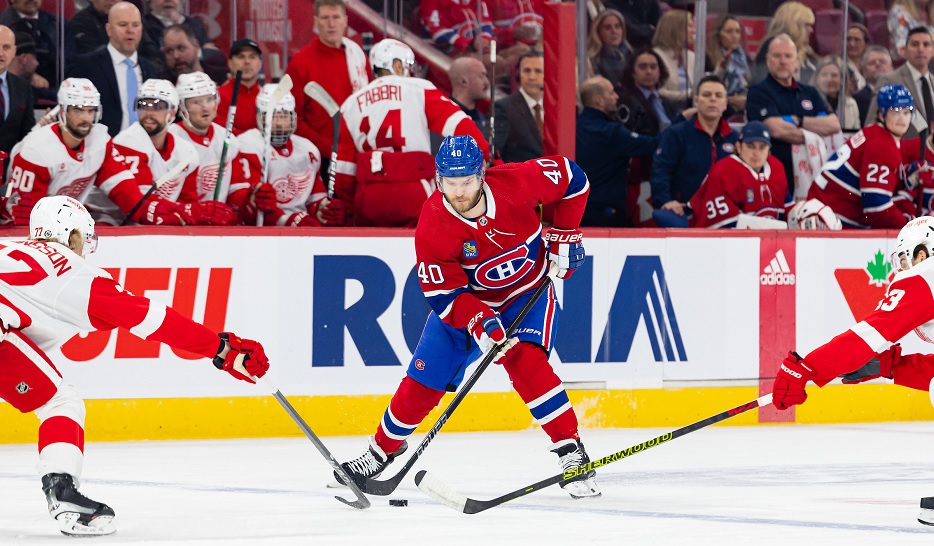HabsWorld.net --
No I cannot forget where it is that I come from.
I cannot forget the people who love me.
Yeah, I can be myself here in this small town.
And people let me just what I want to be.
– John Cougar Mellencamp
Every weekday for over four decades George Gainey woke up every morning at the crack of dawn, turned left and walked down Peterborough’s Driscoll Terrace, crossed over the Hunter Street Bridge and stepped into the Quaker Oats plant.
Each morning the son leaves his condominium in Montreal and heads toward his office at the Bell Centre.
On the cold, winter mornings in Peterborough, George Gainey would always be the one to shovel the snow out of his driveway.
During those wicked Montreal winter mornings, the son would be the one to shovel his own driveway, eschewing the help of many well meaning city workers.
George Gainey was a humble man who disliked talking about himself, not feeling the need to share his own personal memories from the war.
The son is a model of stoicism, a humble man who does not showcase any mementos or symbols of his career on the walls, nor is he comfortable sharing his personal reminisces about the highs and lows of his life.
George Gainey devoted forty-one years of his life to his job at the Quaker Oats plant as a shipping and receiving clerk. It was not a lucrative job, with his pay ranging from .30 cents an hour to $9 dollars an hour when he retired in 1980. For those who knew him however, George Gainey transcended his job and was a pillar of his community as well as one of the town’s most respected members.
Peterborough is a city now that is made up today of close to 80,000 residents. Located on the Otanobee River in central-eastern Ontario, Peterborough is the gateway to the “cottage country” of the Kawartha’s. The people of Peterborough still like to think of themselves as being a conglomerate of city, country, and cottage folk. Peterborough is a place where life is taken at a leisurely pace, were nothing is too rushed, and people revel in their modesty while understanding the value of a hard day’s work for a good day’s pay.
For those outside of town, Peterborough is best known for being one of the preeminent hockey capitals of Canada. It is a part of the country where hockey is not only a passion but also a way of life. The local junior team, the Peterborough Petes, have sent more players to the National Hockey League than any other major junior franchise in Canada. Hockey legends Scotty Bowman, Roger Neilson, Steve Yzerman, and Chris Pronger all coached and played here before going on to careers that led to hockey immortality.
Many however, associate this picturesque town with its most prominent citizen, a local boy who made his way up the local ranks to superstardom with the NHL’s most historic franchise. Over the course of his career he became the face of the franchise, as one of the teams most respected captains, and was chosen to represent his country on the international stage. Named “the greatest hockey player in the world” by the Russian hockey hierarchy, the player after his retirement took his rightful place in the Hockey Hall of Fame. He then was able to make the transformation from player to one of the most distinguished executives in the hockey world.
Despite all the fame however, the son has never forgotten his roots.
His name is Bob Gainey.
For many of us Bob Gainey is remembered as one of the greatest of all Montreal Canadiens, a man who brought a rare combination of tenacity and resolve along with classiness, dignity and a stoicism rarely seen in the modern athlete. And while his playing exploits landed him a permanent place in the Hockey Hall of Fame, and now find him as one of the most respected managers in the hockey world, he has always seemed distant to most of us. A humble man, a private man, Gainey guards his thoughts closely and his feelings even closer.
In today’s era of the boisterous athlete, constantly talking on our television sets night after night, it is the detached Gainey who remains a true enigma even to his biggest supporters.
But if one wants to find the true Bob Gainey, the man behind the private façade, there are small hints to be found on a trip back to Peterborough, where it all began years before at the house on the corner of James and Mark streets, a place where his beloved mother still resides, as her offspring continue to make their mark on the world outside her door.
The house lies in the shadow of the old Quaker plant, a plant that through their fathers work provided for the seven Gainey children, while a community nurtured them. Three of the children entered the teaching profession, one became a dairy farmer, and another became a nurse while yet another one entered the sisterhood. The fifth child, the one that we would all come to know, became a hockey player.
Despite having to work to maintain an average life, the father and his family transcended social class, establishing a level of class and dignity all their own. And while in his career, Bob Gainey was feted by many in out of the hockey world as that rare player whose exceptional abilities pale in comparison to his character it was in Peterborough however, where these traits had been seen before, because what Bob Gainey was to the world, his family was to Peterborough.
Rising through the local ranks, Gainey joined the Peterborough Petes and helped lead them to the Memorial Cup Finals in the spring of 1972. This was not however, the most pivotal moment in the life of the young Bob Gainey. Right around this time Gainey quietly began dating an usherette at the Memorial Centre named Cathy Collins. A local girl that came from a large family of nineteen children, their budding relationship only cemented the connection to their hometown.
Soon Gainey would join the Canadiens, and would quickly become a fixture in his second home of Montreal, where he chose to raise his four children with his new wife. These were the best of times for the Gainey’s on the ice, where the Canadiens dominated the league, and off the ice where the Gainey’s became a treasured part of the community, learning the French language, and where his family acted as a surrogate family for many of the young players and their families making the difficult adjustment to Montreal.
After his retirement at the conclusion of the 1989 season, the Gainey’s spent a year in France, before Bob decided to embark for Minnesota to join the North Stars as their head coach, and then a few years later in Dallas where the relocated Stars became Stanley Cup champions under Gainey’s stewardship as general manager.
With a growing family of three girls and one boy, things should have been idyllic, but the diagnosis of Cathy’s brain cancer in 1990, followed by her untimely death five years later, shattered the Gainey family, leaving Bob, a busy NHL executive, as a single father raising four young children.
Continually showing a brave front along with a quiet dignity, Gainey succeeded in both the hockey worlds and most importantly, in the raising of four fine children into adulthood. After leaving Dallas, taking a year off, and spending most of his time in Peterborough, Gainey took the phone call, the call that brought him back to Montreal as the team’s general manager.
The return to Montreal saw Gainey take over a once dominant Canadiens team that had fallen into a state of malaise. However, thanks to some shrewd maneuvering, Gainey was quickly able to put the Habs back on track.
And then suddenly the unthinkable happened. On December 8th, 2005 Laura Gainey, Bob’s 25 year-old daughter was swept overboard into the frigid waters of the Atlantic. After many extended searches, and with a nation holding it’s collective breath, it was decided to halt the search. Laura Gainey was presumed lost at sea.
Of all the things in life, nothing is more unimaginable than the loss of a child. For this to happen to Bob Gainey, a man considered by many to represent everything good and decent, undoubtedly made the loss even harder to fathom. As a country poured out its support, Bob Gainey’s inner strength, a silent strength was put to its ultimate test.
Like his father before him, Bob Gainey, the private man soon resumed his work, walking each day to his office at the Bell Centre, displaying a rare form of courage.
Soon with the help of his children he formed the Gainey foundation in honour of his beloved wife and adored daughter, to help fund worthwhile causes.
It didn’t take long for Peterborough, his hometown, the place that had always been proudest to call him one of their own, to step up to the plate. Announcing the foundation’s initial fundraiser for last March at the Showplace Theatre the financial goal was set for $60,000.
But if anyone ever had any doubt for the cherished place the Gainey’s hold in Peterborough it was quickly refuted on a night that celebrated the Gainey family, a night that saw all 650 tickets sold out well before the event was even announced to the public.
A thankful Gainey remarked that, “there was a real sense of participation by the community by the city of Peterborough and a real will to do it. The response is born out of people’s knowledge of our family, our participation in the area.”
Sitting there in the crowd, the Gainey family, including his mother, were treated to a performance by a selection of Peterborough’s favourite entertainers.
It was night that celebrated the Gainey family, an extended family that stands as one of the pillars of the community. It was soon announced the fundraiser had doubled it’s initial goal and raised an astounding $120,000 for the foundation.
An overwhelmed and humble Gainey addressed the crowd.
“You decided to grieve with us and move on with us,” begin a grateful Gainey. “And what we’re doing tonight, we’re so appreciative because we know how sincere it is.”
Later this summer, Bob Gainey will return to his summer cottage a little north of Peterborough. He will walk the streets of Peterborough, where to everyone he is simply known as Bob, the local boy who made it big.
On the night of the fundraiser, perhaps Don Cherry said it best in his video tribute.
“What you do is loud, you don’t have to be.”
For more information about the Gainey Foundation, please visit www.gaineyfoundation.com

